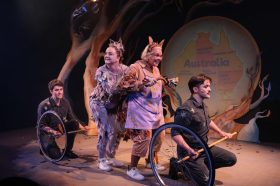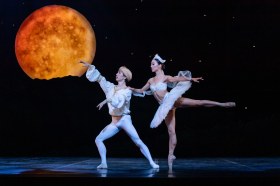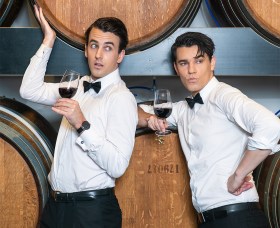Whenever I have been involved in community consultations about cultural development, facilities feature as a very popular topic. Whatever the particular needs of a community are, it seems that either building new facilities or revamping existing ones appear high on the list of ways to address them. The main problem, however, is usually one of resources. Where will the facility be located? Who will pay for its construction? Who will run it? Very often it is local Government who either steps in as the provider and operator, or who effectively kills off the idea by being unable to do so.
Last year I came across a very motivated and self-reliant community group who found a different way, and are prospering. Guided by local artist Kelli Ryan, a group of Indigenous artists have come together in to create Boolarng Nangamai Aboriginal Art and Culture Studio, in Gerringong on the NSW Coast. The name is an apt one, created by combining a word meaning ‘Dreaming’ in the Sydney Dharawal language group (Nangamai) with the word for ‘Together’ in the Biripi language group (Boorlarng). This community of artists do a lot more than just dream together, however, and have firm control of their own cultural development project, independent of the local Council or anyone else.
Kelli, who was awarded a Medal of the Order of Australia in 1995 in recognition of her leadership, met most of the founding artists through her work at West Wollongong TAFE where she worked as an art teacher for more than a decade. After completing their courses, however, Kelli realised that there was nowhere for the artists to go in order to continue their development, to work with a sense of community, or to show their work. As always, a facility was needed.
Instead of depending on others, however, Kelli took up the challenge herself.
Equipped with no more than an idea and a small inheritance form her mother Sheila, she purchased land on Gerringong’s Union Creek – a site for naturally growing reeds that have been used by Aboriginal people in art and craft for many thousands of years. Kelli put forward the idea of building a studio on this land and formed a collective with the artists in order to make it happen.
“I believe my vision and ability to teach others how to believe in themselves has allowed this unique place and experience to come about.” Kelli explains. “Now Aboriginal Culture in this area has a place to practice traditions and ensure they are not lost and that they are passed onto other communities and generation to respect and value.”
The studio runs from an egalitarian structure and utilises a business model which ensures that the lowest possible commissions are taken from the artists sales. By building a number of industrial/warehouse style suites on the site, Kelli cleverly ensured that the main costs would be covered by rent from commercial businesses who have taken up tenancies.
The vision and ambition of these artists continues to grow, however, and although the bricks and mortar are covered, they are reaching out to funding partners and sponsors for a number of exciting program activities. The NSW Ministry for the Arts has assisted in developing their marketing and governance skills, while the Regional Arts NSW contributed to a recent cultural exchange with artists at Art in the Heart conference in Papunya Tjupi and Yirrkalla.
Reconciliation is a key focus of the Studio, and an area which the artists approach in a typically hands-on way. The studio conducts workshops which aim to pass on skills to both people in the Aboriginal and non Aboriginal community. School holiday workshops where Indigenous and non-indigenous children and adults join the artists to learn about and participate in traditional, grass weaving, bush tucker and other activities have been particularly successful. Other activities branch out into painting, drawing, tool making, music, storytelling and dance.
True to Indigenous cultural contructs, however, there is often no clear line between all of these activities. They overlap and integrate, responding to the interests and inclinations of the artists and the participants. This is also reflected in the language and concepts used by Boolarng Nangamai to present their programs. Kelli explains:
“We have developed an online cultural menu whereby visitors can have a unique online internet experience directly with each cultural worker. The BN menu is just like a restaurant, with a broad range of Aboriginal cultural delights. The artists are like a ‘dish’ on the menu. When you visit the site you can choose from the samples and book in for a session on the topic that interests you. Once you are here, you will laugh, listen and learn about Aboriginal life.”
Nine founding artists working with Kelli in opening the studio in 2005. Debbie Callaghan is a painter, originally from Queensland whose work includes public art projects and a recent exhibition in Paris, as have Steven Russell, Phyllis Stewart and Mabel Dungay, who are all both weavers and painters. Bonny Foley Brennan works in the same media and has a very distinctive figurative painting style.
Landscape painter Lila Lawrence has a rich oeuvre, drawing on memories of places and the land she has travelled. Russell Ping is a painter from Purfleet who does the same but in a more abstract way and with an interest in the urban landscape.
Noel Lonesborough is from Nowra and is an accomplished potter who also paints, and he is heavily involved in Native Plant Seed collecting & propagating as part of the BN Bush foods and Medicine Garden at the Studio.
Twenty other artists and cultural workers have subsequently joined the studio as associates. They include the prodigiously talented nine year old Adelaide Stewart and her mother Kristine Stewart who is a designer and maker of jewellery and a painter.
These artists share a style of art that is contemporary, and created from their own experience, but it is also rooted in the oral history of the South Coast. In their own words they are:
“…recording our history in art in a contemporary way – retracing our memories & experiences in addition to what our elders taught us. When we visit other Aboriginal nations we see the direct link that has not been interrupted by white mans impact – things are different here we have had to adapt but the passion is still within us – we only have to walk the land and the old fellas we still feel it – the land our people, their spirit – even if a city is near by.”
“In developing our own visual language we look into the land and you hear and smell our culture. We walk the land and see axe grinding grooves, middens, and engravings, drawing, stencils and feel our ancestors with us. We are living history – we are both traditional & contemporary existing in this time. Our image making has moved from traditional ways into modern expression but the songlines that run through our country are the same as our blood lines that pass through us to our children to our Dreaming”
So the past, present and future are all encapsulated in the art and cultural practise of this self proclaimed ‘South Coast Mob”. It is no surprise then to learn that future programs planned by the artists include traineeships and apprenticeships. These programs will differ from most similar programs, however, as they will utilise traditional approaches of learning via a direct transfer of knowledge from elders to the young.
Gerringong is a comfortable 90 minute drive from Sydney and the studio is regularly open to enable visitors to observe Indigenous artists at work in their own environment. The studio showcases artwork for sale and on exhibition. Visitors can buy artworks, woven objects, bush tucker or attend workshops and other activities.




